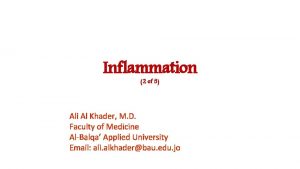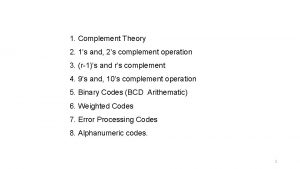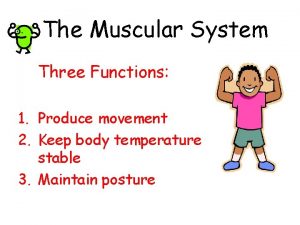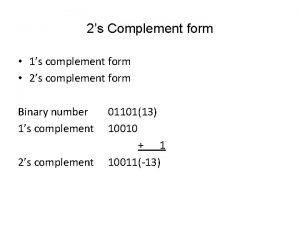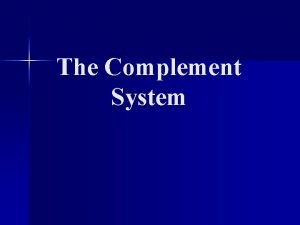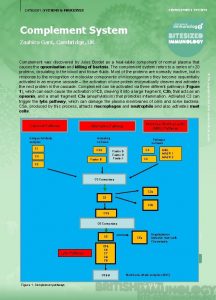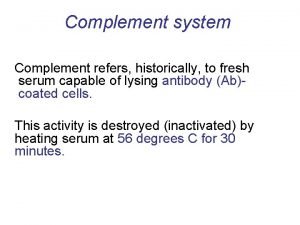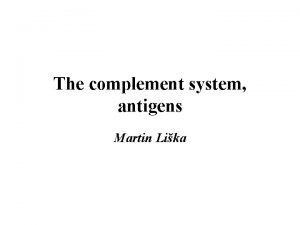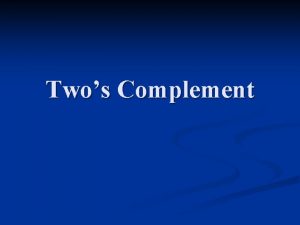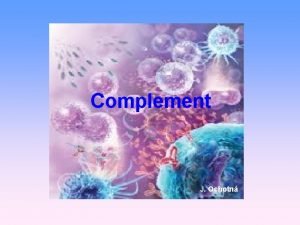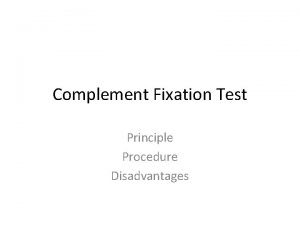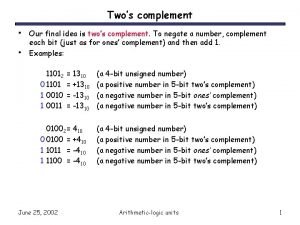The complement system Complement has three functions Opsonin








































- Slides: 40

The complement system

• Complement has three functions: – Opsonin – Chemoattractant – Membrane Attack Complex (MAC) • Complement functions in two (three? ) systems: – Alternative – Classical – Lectin-based

The complement system • A defensive system consisting of over 30 proteins produced by the liver and found in circulating blood serum. • Complement kills microbes in three different ways – 1. opsonization – 2. inflammation – 3. Cytolysis

• Complement refers to a complex set of 14 distinct serum proteins (nine components) that are involved in three separate pathways of activation. – Components numbered in order of discovery. – Sequence of activation is not in numerical order. – Components circulate in inactive precursor form, develop activity upon activation. • Complement proteins designated by “C” followed by numbers and letters.

• Promote the inflammatory response by opsonization which enhances susceptibility of coated cells to phagocytosis. • Alter biological membranes to cause direct cell lysis

General Properties of Complement • Primary role is cell lysis. • Activity of complement destroyed by heating sera to 56 C for 30 minutes. • Ig. M and Ig. G are the only immunoglobulin capable of activating complement (classical pathway). • Complement activation can be initiated by complex polysaccharides or enzymes (alternative or properdin pathway). • Portions of the complement system contribute to chemotaxis, opsonization, immune adherence, anaphylatoxin formation, virus neutralization, and other physiologic functions

A Cascade system • The complement works as a cascade system. – Cascade is when one reaction triggers another reaction which trigger others and so on. These types of systems can grow exponentially very fast.

THREE PATHWAYS

Cascade activation • Complement proteins are often designated by an uppercase letter C and are inactive until they are split into products. – Example: C 1 • When the products are split they become active. The active products are usually designated with a lower case a or b. – Example: C 1 a and C 1 b

Two Pathways • The complement pathway can be activated by either of two different pathways. – Classical pathway (specific immune system) – alternative (non-specific immune system)

The Classical Pathway • The classical pathway is considered to be part of the specific immune response because it relies on antibodies to initiate it. • C 1 becomes activated when it binds to the ends of antibodies

• C 1: The Recognition Unit – C 1 consists of 3 subunits: C 1 q, C 1 r, and C 1 s. – C 1 q molecule consists of a collagenous region with six globular head groups globe end serves as recognition unit – When antibody binds to antigen, binding sites for the globular head groups of C 1 q are exposed on the Fc region of the antibody. – For C 1 q to initiate the cascade it must attach to at least 2 Fc fragments, requires at least 2 molecules of Ig. G or one molecule of Ig. M. – C 1 q binding causes C 1 r to enzymatically activate C 1 s.

The Activation Unit (C 4 b 2 a 3 b) • C 1 s cleaves C 4 into C 4 a and C 4 b • C 1 s cleaves C 2 into C 2 a and C 2 b • C 4 b 2 a (C 4 b 2 b in some texts) is enzymatically active and can cleave many molecules of C 3 into C 3 a and C 3 b.

Membrane Attack Unit (C 5, 6, 7, 8, 9) • In the presence of C 5 b, molecules of C 6, C 7, C 8 and a variable number of C 9 molecules assemble themselves into aggregates. • This molecular complex causes a change in membrane permeability. • Exact cause of lysis unknown, one theory is change in lipid membrane causes exchange of ions and water molecules across membrane. • Cells can lyse without C 9 but it’s slower.

The building of a C 3 activation complex • Once C 1 is activated, it activates 2 other complement proteins, C 2 and C 4 by cutting them in half • C 2 is cleaved into C 2 a and C 2 b • C 4 is cleaved into C 4 a and C 4 b • Both C 2 b and C 4 b bind together on the surface of the bacteria • C 2 a and C 4 a diffuse away

C 3 Activation complex • C 2 b and C 4 b bind together on the surface to form a C 3 activation complex • The function of the C 3 activation complex is to activate C 3 proteins. – This is done by cleaving C 3 into C 3 a and C 3 b

C 3 b • Many C 3 b molecules are produced by the C 3 activation complex. • The C 3 b bind to and coat the surface of the bacteria. • C 3 b is an opsonin – Opsonins are molecules that bind both to bacteria and phagocytes – Opsonization increases phagocytosis by 1, 000 fold. Opsonins eria Bact

C 3 a increases the inflammatory response by binding to mast cells and causing them to release histamine

Building the C 5 activation complex • Eventially enough C 3 b is cleaved that the surface of the bacteria begins to become saturated with it. • C 2 b and C 4 b which make up the C 3 activation complex has a slight affinity for C 3 b and C 3 b binds to them • When C 3 b binds to C 2 b and C 4 b it forms a new complex referred to as the C 5 activation complex

The C 5 activation complex • The C 5 activation complex (C 2 b, C 4 b, C 3 b) activates C 5 proteins by cleaving them into C 5 a and C 5 b • Many C 5 b proteins are produced by the C 5 activation complex. These C 5 b begin to coat the surface of the bacteria.

The function of C 5 a • C 5 a disperses away from the bacteria. – Binds to mast cells and increases inflammation. – Most powerful chemotactic factor known for leukocytes

Building the Membrane Attack complex • C 5 b on the surface of bacteria binds to C 6 • The binding of C 6 to C 5 b activates C 6 so that it can bind to C 7 • C 7 binds to C 8 which in turn binds to many C 9’s • Together these proteins form a circular complex called the Membrane attack complex (MAC)

Membrane Attack complex • The MAC causes Cytolysis. – The circular membrane attack complex acts as a channel in which cytoplasm can rush out of and water rushes in. • The cells inner integrity is compromised and it dies • Animation of the classical pathaway

Overview

The alternative pathway • The alternative pathway is part of the nonspecific defense because it does not need antibodies to initiate the pathway. • The alternative pathway is slower than the Classical pathway

Alternative Pathway (Properdin Pathway) • Cleavage of C 3 and activation of the remainder of the complement cascade occurs independently of antibody. • Triggers for the alternative pathway include – Bacterial cell walls – Bacterial lipopolysaccharide – Fungal cell walls – Virally infected cells – Rabbit erythrocytes

Alternative Pathway (Properdin Pathway) • Molecules of C 3 undergo cleavage at continuous low level in normal plasma. • At least 4 serum proteins (factor B, factor D, properdin (P), and initiating factor (IF) function in this pathway. • C 3 b attaches to appropriate site (activating surface) which is actually a protective surface

Alternative Pathway (Properdin Pathway) • Action by the 4 serum proteins on C 3 b proceeds to the C 3 activator stage without participation of C 1, C 4 or C 2. • Activation sequence: C 3, C 5, C 6, C 7, C 8, C 9.

The Alternative complement pathway

Initiation of The Alternative pathway • C 3 contains in unstable thioester bond. • This unstable bond makes. C 3 subject to slow spontaneous hydrolysis to C 3 b and C 3 a • The C 3 b is able to bind to foreign surface antigens. • Mammalian cells which inactivates C 3 b

Factor B • C 3 b on the surface of a foreign cells binds to another plasma protein called factor B

Factor D • The binding of C 3 b to factor B allows a protein enzyme called Factor D to cleave Factor B to Ba and Bb. • Factor Bb remains bound to C 3 b while Ba and Factor D disperse away.

The C 3 activation complex • Properdin, also called factor P, binds to the C 3 b. Bb complex to stabilize it. • C 3 b. Bb. P make up the C 3 activation complex for the alternative pathway

The C 3 activation Complex • The C 3 activation complex causes the production of more C 3 b. • This allows the initial steps of this pathway to be repeated and amplified • 2 X 106 molecules can be generated in 5 minutes

C 5 activation complex • When an additional C 3 b binds to the C 3 activation complex it converts it into a C 5 activation complex. • The C 5 activation complex cleaves C 5 into C 5 a and C 5 b. • C 5 b begins the production of the MAC.

Lectin Pathway • Activation of the lectin pathway begins when mannan-binding protein (MBP) binds to the mannose groups of microbial carbohydrates. • Two more lectin pathway proteins called MASP 1 and MASP 2 (equivalent to C 1 r and C 1 s of the classical pathway) bind to the MBP. • This forms an enzyme similar to C 1 of the classical complement pathway that is able to cleave C 4 and C 2 to form C 44 b. C 2 a, the C 3 convertase capable of enzymatically splitting hundreds of molecules of C 3 into C 3 a and C 3 b

Lectin Pathway The beneficial results are the same as in the classical complement pathway: Trigger inflammation (C 5 a>C 3 a>C 4 a); Chemotactically attract phagocytes to the infection site (C 5 a); Promote the attachment of antigens to phagocytes via enhanced attachment or opsonization (C 3 b>C 4 b; Serves as a second signal for the activation of naive B-lymphocytes (C 3 d); Cause lysis of gram-negative bacteria and human cells displaying foreign epitopes (MAC). And remove harmful immune complexes from the

Overview

Activation of the Lectin Pathway C 3 b mannan binding lectin (MBL) mannose sugars C 3 convertase C 3 MBL C 3 b covalent bond with surface “activating surface” (bacterial or yeast cell surface) -mannan binding lectin (MBL) recognizes mannose sugars on microbial cells -host mannose is hidden and is not accessible to MBL -lectin pathway results in the formation of a C 3 convertase that generates C 3 b -C 3 b forms a covalent bond with the surface of the pathogen and is part of C 5 convertase

 Opsonin
Opsonin Venn diagram word problems
Venn diagram word problems Bcd subtraction using 1's complement
Bcd subtraction using 1's complement What are three functions of money?
What are three functions of money? Neuron anatomy
Neuron anatomy How do muscles move
How do muscles move Tear past and past participle
Tear past and past participle Hát kết hợp bộ gõ cơ thể
Hát kết hợp bộ gõ cơ thể Slidetodoc
Slidetodoc Bổ thể
Bổ thể Tỉ lệ cơ thể trẻ em
Tỉ lệ cơ thể trẻ em Chó sói
Chó sói Tư thế worm breton
Tư thế worm breton Hát lên người ơi alleluia
Hát lên người ơi alleluia Các môn thể thao bắt đầu bằng tiếng đua
Các môn thể thao bắt đầu bằng tiếng đua Thế nào là hệ số cao nhất
Thế nào là hệ số cao nhất Các châu lục và đại dương trên thế giới
Các châu lục và đại dương trên thế giới Công thức tính thế năng
Công thức tính thế năng Trời xanh đây là của chúng ta thể thơ
Trời xanh đây là của chúng ta thể thơ Cách giải mật thư tọa độ
Cách giải mật thư tọa độ Làm thế nào để 102-1=99
Làm thế nào để 102-1=99 Phản ứng thế ankan
Phản ứng thế ankan Các châu lục và đại dương trên thế giới
Các châu lục và đại dương trên thế giới Thơ thất ngôn tứ tuyệt đường luật
Thơ thất ngôn tứ tuyệt đường luật Quá trình desamine hóa có thể tạo ra
Quá trình desamine hóa có thể tạo ra Một số thể thơ truyền thống
Một số thể thơ truyền thống Cái miệng nó xinh thế
Cái miệng nó xinh thế Vẽ hình chiếu vuông góc của vật thể sau
Vẽ hình chiếu vuông góc của vật thể sau Nguyên nhân của sự mỏi cơ sinh 8
Nguyên nhân của sự mỏi cơ sinh 8 đặc điểm cơ thể của người tối cổ
đặc điểm cơ thể của người tối cổ Giọng cùng tên là
Giọng cùng tên là Vẽ hình chiếu đứng bằng cạnh của vật thể
Vẽ hình chiếu đứng bằng cạnh của vật thể Fecboak
Fecboak Thẻ vin
Thẻ vin đại từ thay thế
đại từ thay thế điện thế nghỉ
điện thế nghỉ Tư thế ngồi viết
Tư thế ngồi viết Diễn thế sinh thái là
Diễn thế sinh thái là Dot
Dot Số.nguyên tố
Số.nguyên tố Tư thế ngồi viết
Tư thế ngồi viết
